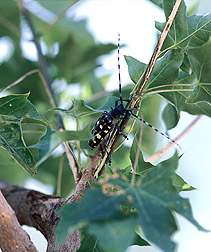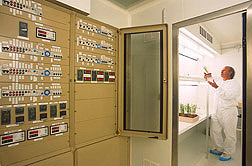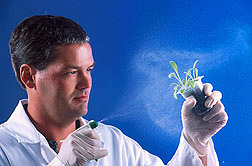OverseasCollections Help Solve Domestic Problems
|
|
Many of the plants and insects that invade and harm our native ecosystems originate overseas. Therefore, it’s no surprise that ARS’s overseas laboratories play a vital role in our quest to prevent invasive species from completely taking over. The scientists at these laboratories have amassed collections of thousands of specimens found during expeditions. These collections—housed at the laboratories in Montpellier, France; Hurlingham, Argentina; Brisbane, Australia; and Beijing, China—serve as an important resource in identifying and evaluating potential biocontrol agents.
From Europe, With Biocontrols
Walker Jones and colleagues at ARS’s European Biological Control Laboratory (EBCL) in Montpellier, France, are true explorers.
Each year, they log thousands of miles traveling through Eastern and Western Europe, Africa, the Middle East, the Balkans, and Asia in search of natural enemies of some of North America’s costliest invasive species. These include insects such as the Asian longhorned beetle, emerald ash borer, olive fruit fly, and wheat stem sawfly, as well as noxious weeds like giant reed, leafy spurge, and yellow starthistle.
U.S. farmers and property owners aren’t the only ones who feel the economic pinch when such exotic species become established on U.S. soils; native flora and fauna also suffer. Infestations of giant reed, Arundo donax, for example, can rapidly take over rivers and other wetland areas, outcompeting indigenous plants for water and depriving wildlife of natural habitat.
|
|
The problem is, these invaders typically arrive without their homeland’s natural enemies. But it’s been a stated goal of EBCL to reacquaint the invaders with their old foes—even if it means scouring the four corners of the globe. Insect, mite, and pathogen specimens acquired from such excursions are returned to EBCL under quarantine. There, they are increased in number and subjected to rigorous testing to ascertain their fitness and safety as candidate biocontrol agents that could eventually be used stateside.
Over the past several decades, for example, the lab’s beneficial microorganism collection has grown to some 2,000 specimens, including isolates of Beauveria and other fungal species with potential to biologically battle invasive weeds and insects, such as the Formosan termite.
In the process, EBCL researchers have amassed a wealth of information about the specimens they’ve collected and scrutinized. The lab maintains Europe’s most extensive collection of beneficial-insect specimens, housed in a climate-controlled room within 26 cabinets and dozens of individual boxes, each related to specific past projects. Many beneficial pathogens are maintained in superfreezers to sustain their viability. A large, preserved plant collection containing important voucher specimens—pressed and dried plants used for reference—has also been accumulated over many years. EBCL began operations in 1919.
Jones, EBCL director since 2005, says, “The collection is currently being identified and catalogued for eventual accessibility through an electronic database.”
Discoveries From Down Under
Scientists at ARS’s Australian Biological Control Laboratory (ABCL) travel throughout Australia and Southeast Asia in their search for insects that could be used as biocontrols for invasive weeds and insects in the United States.
“Over the past 24 years, we have accumulated an extensive collection of specimens from our expeditions and surveys,” says lab director Matthew Purcell. “With excellent collaborators, we have the capability to explore countries such as Singapore, Thailand, China, Malaysia, and Indonesia to find the most promising biocontrol agents.”
Stored at the laboratory in Brisbane, the collection contains tens of thousands of specimens of herbivorous and parasitic insects. Professionally preserved for permanent storage on pins or in vials of alcohol, specimens are often used in genetic characterization and by taxonomists to conduct systematic studies and identify cryptic species—new species that look identical to those already known.
“The collection benefits the scientific community, given that a large percentage of the insects we collect are unknown to science,” adds Purcell. “We are increasing the knowledge of biodiversity across different habitats and ecosystems in Australia and Southeast Asia.”
|
|
More than 450 insect species in the collection were identified as feeding on melaleuca alone. Melaleuca quinquenervia, commonly known as the “Australian broad-leaved paperbark tree,” is a serious invasive plant in Florida that has caused extensive environmental and economic damage to the Everglades and surrounding areas.
Although biocontrol agents for Melaleuca have been released and are thriving, the Brisbane scientists continue to search for other insects to add to the arsenal being used to stop the weed’s spread. Specimen data from insects in the collection help identify the host range, seasonality, and climatic restrictions of new agents—key factors in evaluating a biocontrol candidate’s potential.
In addition, the collection houses samples of targeted weeds. These samples are used to help characterize and genetically match weeds in the exotic range with specimens from the native range. This has become an essential component in selecting effective, host-specific biocontrol agents.
Fighting South American Invasive Pests
Since 1962, ARS’s South American Biological Control Laboratory (SABCL) in Hurlingham, Argentina, has played an invaluable role in assisting ARS scientists—both in the United States and at other international labs—with its herbarium, which now houses more than 2,200 dried specimens. This collection has been recently identified and catalogued and is available through an electronic database.
In addition, SABCL has an insect collection of about 6,000 pinned specimens, and thousands more specimens are preserved in alcohol. Many of the insects are new to science. The collection will be sorted soon.
Juan Briano, the lab’s director since 2003, and the scientific team at SABCL have explored Argentina, Bolivia, Brazil, Chile, Paraguay, Peru, and Uruguay and studied the abundance, biology, efficacy, and specificity of hundreds of natural enemies of several dozen invasive pests that were introduced into the United States from South America.
Both the insect and plant collections at SABCL are continuously updated with new specimens collected during field explorations. Current projects there include work with water hyacinth, alligatorweed, Brazilian pepper-tree, fanwort, balloon vine, pompom weed, Brazilian waterweed, water primrose, Lippia, Parkinsonia, water lettuce, imported fire ants, glassy-winged sharpshooter, cactus moth, little fire ant, and cactus mealybug. Cooperative agreements exist between SABCL and Australia and South Africa.—By Stephanie Yao, Jan Suszkiw, and Alfredo Flores, Agricultural Research Service Information Staff.
This research is part of Veterinary, Medical, and Urban Entomology (#104) and Crop Protection and Quarantine (#304), two ARS national programs described at www.nps.ars.usda.gov.
To reach scientists mentioned in this article, contact Stephanie Yao, USDA-ARS Information Staff, 5601 Sunnyside Ave., Beltsville, MD 20705; (301) 504-1619.
"OverseasCollections Help Solve Domestic Problems" was published in the January 2010 issue of Agricultural Research magazine.










